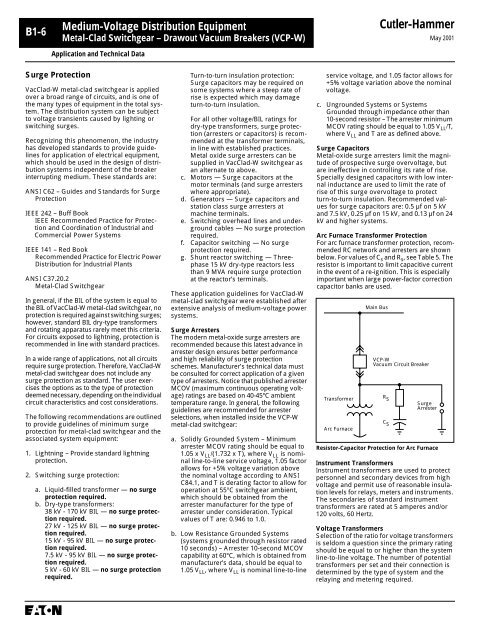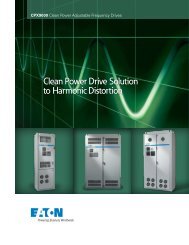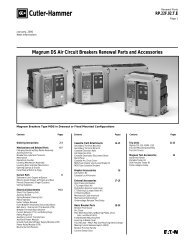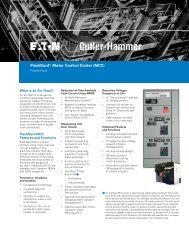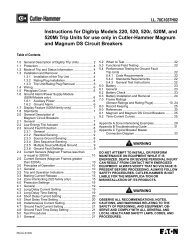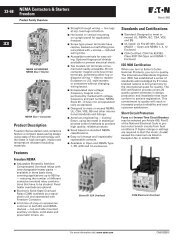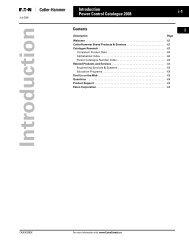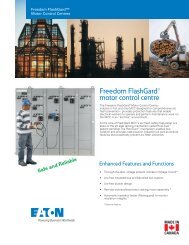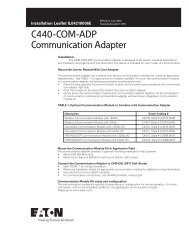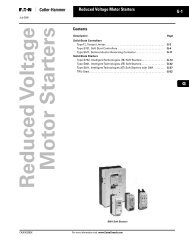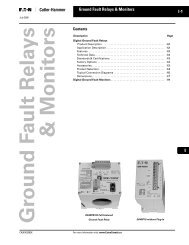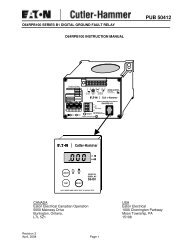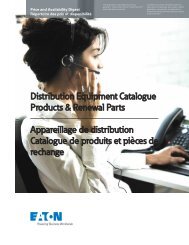Cutler-Hammer - Eaton Canada
Cutler-Hammer - Eaton Canada
Cutler-Hammer - Eaton Canada
You also want an ePaper? Increase the reach of your titles
YUMPU automatically turns print PDFs into web optimized ePapers that Google loves.
B1-6<br />
Surge Protection<br />
Medium-Voltage Distribution Equipment<br />
Metal-Clad Switchgear – Drawout Vacuum Breakers (VCP-W)<br />
Application and Technical Data<br />
VacClad-W metal-clad switchgear is applied<br />
over a broad range of circuits, and is one of<br />
the many types of equipment in the total system.<br />
The distribution system can be subject<br />
to voltage transients caused by lighting or<br />
switching surges.<br />
Recognizing this phenomenon, the industry<br />
has developed standards to provide guidelines<br />
for application of electrical equipment,<br />
which should be used in the design of distribution<br />
systems independent of the breaker<br />
interrupting medium. These standards are:<br />
ANSI C62 – Guides and Standards for Surge<br />
Protection<br />
IEEE 242 – Buff Book<br />
IEEE Recommended Practice for Protection<br />
and Coordination of Industrial and<br />
Commercial Power Systems<br />
IEEE 141 – Red Book<br />
Recommended Practice for Electric Power<br />
Distribution for Industrial Plants<br />
ANSI C37.20.2<br />
Metal-Clad Switchgear<br />
In general, if the BIL of the system is equal to<br />
the BIL of VacClad-W metal-clad switchgear, no<br />
protection is required against switching surges;<br />
however, standard BIL dry-type transformers<br />
and rotating apparatus rarely meet this criteria.<br />
For circuits exposed to lightning, protection is<br />
recommended in line with standard practices.<br />
In a wide range of applications, not all circuits<br />
require surge protection. Therefore, VacClad-W<br />
metal-clad switchgear does not include any<br />
surge protection as standard. The user exercises<br />
the options as to the type of protection<br />
deemed necessary, depending on the individual<br />
circuit characteristics and cost considerations.<br />
The following recommendations are outlined<br />
to provide guidelines of minimum surge<br />
protection for metal-clad switchgear and the<br />
associated system equipment:<br />
1. Lightning – Provide standard lightning<br />
protection.<br />
2. Switching surge protection:<br />
a. Liquid-filled transformer — no surge<br />
protection required.<br />
b. Dry-type transformers:<br />
38 kV - 170 kV BIL — no surge protection<br />
required.<br />
27 kV - 125 kV BIL — no surge protection<br />
required.<br />
15 kV - 95 kV BIL — no surge protection<br />
required.<br />
7.5 kV - 95 kV BIL — no surge protection<br />
required.<br />
5 kV - 60 kV BIL — no surge protection<br />
required.<br />
Turn-to-turn insulation protection:<br />
Surge capacitors may be required on<br />
some systems where a steep rate of<br />
rise is expected which may damage<br />
turn-to-turn insulation.<br />
For all other voltage/BIL ratings for<br />
dry-type transformers, surge protection<br />
(arresters or capacitors) is recommended<br />
at the transformer terminals,<br />
in line with established practices.<br />
Metal oxide surge arresters can be<br />
supplied in VacClad-W switchgear as<br />
an alternate to above.<br />
c. Motors — Surge capacitors at the<br />
motor terminals (and surge arresters<br />
where appropriate).<br />
d. Generators — Surge capacitors and<br />
station class surge arresters at<br />
machine terminals.<br />
e. Switching overhead lines and underground<br />
cables — No surge protection<br />
required.<br />
f. Capacitor switching — No surge<br />
protection required.<br />
g. Shunt reactor switching — Threephase<br />
15 kV dry-type reactors less<br />
than 9 MVA require surge protection<br />
at the reactor’s terminals.<br />
These application guidelines for VacClad-W<br />
metal-clad switchgear were established after<br />
extensive analysis of medium-voltage power<br />
systems.<br />
Surge Arresters<br />
The modern metal-oxide surge arresters are<br />
recommended because this latest advance in<br />
arrester design ensures better performance<br />
and high reliability of surge protection<br />
schemes. Manufacturer’s technical data must<br />
be consulted for correct application of a given<br />
type of arresters. Notice that published arrester<br />
MCOV (maximum continuous operating voltage)<br />
ratings are based on 40-45°C ambient<br />
temperature range. In general, the following<br />
guidelines are recommended for arrester<br />
selections, when installed inside the VCP-W<br />
metal-clad switchgear:<br />
a. Solidly Grounded System – Minimum<br />
arrester MCOV rating should be equal to<br />
1.05 x VLL/(1.732<br />
x T), where VLL<br />
is nominal<br />
line-to-line service voltage, 1.05 factor<br />
allows for +5% voltage variation above<br />
the nominal voltage according to ANSI<br />
C84.1, and T is derating factor to allow for<br />
operation at 55°C switchgear ambient,<br />
which should be obtained from the<br />
arrester manufacturer for the type of<br />
arrester under consideration. Typical<br />
values of T are: 0.946 to 1.0.<br />
b. Low Resistance Grounded Systems<br />
(systems grounded through resistor rated<br />
10 seconds) – Arrester 10-second MCOV<br />
capability at 60°C, which is obtained from<br />
manufacturer’s data, should be equal to<br />
1.05 VLL,<br />
where VLL<br />
is nominal line-to-line<br />
<strong>Cutler</strong>-<strong>Hammer</strong><br />
May 2001<br />
service voltage, and 1.05 factor allows for<br />
+5% voltage variation above the nominal<br />
voltage.<br />
c. Ungrounded Systems or Systems<br />
Grounded through impedance other than<br />
10-second resistor – The arrester minimum<br />
MCOV rating should be equal to 1.05 VLL/T,<br />
where VLL<br />
and T are as defined above.<br />
Surge Capacitors<br />
Metal-oxide surge arresters limit the magnitude<br />
of prospective surge overvoltage, but<br />
are ineffective in controlling its rate of rise.<br />
Specially designed capacitors with low internal<br />
inductance are used to limit the rate of<br />
rise of this surge overvoltage to protect<br />
turn-to-turn insulation. Recommended values<br />
for surge capacitors are: 0.5 µf on 5 kV<br />
and 7.5 kV, 0.25 µf on 15 kV, and 0.13 µf on 24<br />
kV and higher systems.<br />
Arc Furnace Transformer Protection<br />
For arc furnace transformer protection, recommended<br />
RC network and arresters are shown<br />
below. For values of Cs<br />
and Rs,<br />
see Table 5. The<br />
resistor is important to limit capacitive current<br />
in the event of a re-ignition. This is especially<br />
important when large power-factor correction<br />
capacitor banks are used.<br />
Transformer<br />
Arc Furnace<br />
Main Bus<br />
VCP-W<br />
Vacuum Circuit Breaker<br />
R S<br />
C S<br />
Surge<br />
Arrester<br />
Resistor-Capacitor Protection for Arc Furnace<br />
Instrument Transformers<br />
Instrument transformers are used to protect<br />
personnel and secondary devices from high<br />
voltage and permit use of reasonable insulation<br />
levels for relays, meters and instruments.<br />
The secondaries of standard instrument<br />
transformers are rated at 5 amperes and/or<br />
120 volts, 60 Hertz.<br />
Voltage Transformers<br />
Selection of the ratio for voltage transformers<br />
is seldom a question since the primary rating<br />
should be equal to or higher than the system<br />
line-to-line voltage. The number of potential<br />
transformers per set and their connection is<br />
determined by the type of system and the<br />
relaying and metering required.


